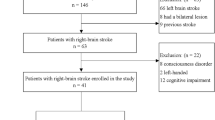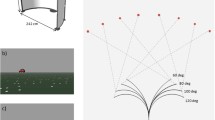Abstract
The most prominent deficit in patients with spatial neglect is a bias of their active behaviour, i. e. a deviation of exploratory movements towards the right. When searching for targets, copying, or reading, the patients direct their eye and hand movements towards the ipsilesional side, leading to neglect of the contralesional side. The present study investigated whether spatial neglect is predominantly linked with such active behaviour or if it is obvious also without any explicit requirements, namely in the patients' spontaneous eye and head position. To address this issue we investigated the patients' spontaneous resting position while "doing nothing", i. e. just sitting and waiting for an experiment to start. Using magnetic search coil technique, we recorded spontaneous eye–in–head and head–on–trunk orientation in that waiting period in 24 patients with and without spatial neglect. In contrast to controls, neglect patients showed a marked deviation of spontaneous eye and head orientation of about 30° (= gaze position) towards the right. The findings strengthen the view that one component of the behaviour in neglect patients is due to a very elementary disturbance of spatial information processing. The deviation of eye and head may be understood as a pathological adjustment of the subject's normal resting position to a more rightward position. While the position in healthy subjects is in line with trunk orientation, this "default position" is shifted to a new origin in patients with spatial neglect.
Similar content being viewed by others
References
Abderhalden E (1926) Lehrbuch der Physiologie in Vorlesungen, Bd 3. Urban and Schwarzenberg, Berlin
Bisiach E, Vallar G (1988) Hemineglect in humans. In: Boller F, Grafman J (eds) Handbook of Neuropsychology, Vol. 1. Elsevier, Amsterdam, pp 195–222
De Renzi E, Colombo A, Faglioni P, Gilbertoni M (1982) Conjugate gaze paresis in stroke patients with unilateral damage. Arch Neurol 39:482–486
De Renzi E, Gentilini M, Faglioni P, Barbieri C (1989) Attentional shift towards the rightmost stimuli in patients with left visual neglect. Cortex 25:231–237
Ferber S, Karnath H-O (2001) How to assess spatial neglect – line bisection or cancellation tasks? J Clin Exp Neuropsychol 23:599–607
Friedland RP, Weinstein EA (1977) Hemi-inattention and hemisphere specialization: introduction and historical review. Adv Neurol 18:1–31
Gauthier L, Dehaut F, Joanette Y (1989) The bells test: a quantitative and qualitative test for visual neglect. Int Clin Neuropsychol 11:49–54
Halligan PW, Marshall JC, Wade DT (1989) Visuospatial neglect: underlying factors and test sensitivity. Lancet 2:908–911
Heilman KM, Valenstein E, Watson RT (1984) Neglect and related disorders. Semin Neurol 4:209–219
Hornak J (1992) Ocular exploration in the dark by patients with visual neglect. Neuropsychologia 30:547–552
Husain M, Kennard C (1997) Distractor- dependent frontal neglect. Neuropsychologia 35:829–841
Johannsen L, Karnath H-O (2004) How efficient is a simple copying task to diagnose spatial neglect in its chronic phase. J Clin Exp Neuropsychol 26:251–256
Johnston CW, Diller L (1986) Exploratory eye movements and visual hemi-neglect. J Clin Exp Neuropsychol 8:93–101
Jung R (1953) Neurophysiologische Untersuchungsmethoden. In: Bergmann G v, Frey W, Schwiegk H (eds) Handbuch der Inneren Medizin, Bd. V. Springer, Berlin, pp 1206–1420
Kaplan RF, Verfaellie M, Meadows M-E, Caplan L, Pessin MS, DeWitt D (1991) Changing attentional demands in left hemispatial neglect. Arch Neurol 48:1263–1266
Karnath H-O (1994) Disturbed coordinate transformation in the neural representation of space as the crucial mechanism leading to neglect. Neuropsychol Rehabil 4:147–150
Karnath H-O (1997) Spatial orientation and the representation of space with parietal lobe lesions. Philos Trans R Soc Lond B Biol Sci 352:1411–1419
Karnath H-O, Huber W (1992) Abnormal eye movement behaviour during text reading in neglect syndrome: a case study. Neuropsychologia 30:593–598
Karnath H-O, Perenin M-T (1998) Tactile exploration of peripersonal space in patients with neglect. Neuroreport 9:2273–2277
Karnath H-O, Fetter M, Dichgans J (1996) Ocular exploration of space as a function of neck proprioceptive and vestibular input-observations in normal subjects and patients with spatial neglect after parietal lesions. Exp Brain Res 109:333–342
Karnath H-O, Niemeier M, Dichgans J (1998) Space exploration in neglect. Brain 121:2357–2367
Karnath H-O, Himmelbach M, Perenin M-T (2003) Neglect-like behaviour in healthy subjects: dissociation of space exploration and goal-directed pointing following vestibular stimulation. Exp Brain Res 153:231–238
Kartsounis LD, Findley LJ (1994) Task specific visuospatial neglect related to density and salience of stimuli. Cortex 30:647–659
Kinsbourne M (1970) A model for the mechanism of unilateral neglect of space. Trans Am Neurol Assoc 95:143–146
Kömpf D, Gmeiner HJ (1988) Gaze palsy and visual hemineglect in acute hemisphere lesions. Neuroophthalmology 9:49–53
Mark VW, Kooistra CA, Heilman KM (1988) Hemispatial neglect affected by non-neglected stimuli. Neurology 38:1207–1211
Parton A, Malhotra P, Husain M (2004) Hemispatial neglect. J Neurol Neurosurg Psychiatry 75:13–21
Pouget A, Driver J (2000) Relating unilateral neglect to the neural coding of space. Curr Opin Neurobiol 10:242–249
Rapcsak SZ, Verfaellie M, Fleet S, Heilman KM (1989) Selective attention in hemispatial neglect. Arch Neurol 46:178–182
Rizzolatti G, Berti A (1990) Neglect as a neural representation deficit. Rev Neurol (Paris) 146:626–634
Rizzolatti G, Gentilucci M, Matelli M (1985) Selective spatial attention: one center, one circuit or many circuits? In: Posner MI, Marin OSM (eds) Attention and performance, XI. Lawrence Erlbaum, Hillsdale NJ, pp 251–265
Robinson DA (1963) A method of measuring eye movements using a scleral search coil in a magnetic field. IEEE Trans Biomed Eng 10:137–145
Rubens AB (1985) Caloric stimulation and unilateral visual neglect. Neurology 35:1019–1024
Vallar G, Papagno C, Rusconi ML, Bisiach E (1995) Vestibular stimulation, spatial hemineglect and dysphasia, selective effects. Cortex 31:589–93
Weintraub S, Mesulam MM (1985) Mental state assessment of young and elderly adults in behavioral neurology. In: Mesulam MM (ed) Principles of behavioural neurology. FA Davis Company, Philadelphia, pp 71–123
Author information
Authors and Affiliations
Corresponding author
Rights and permissions
About this article
Cite this article
Fruhmann-Berger, M., Karnath, HO. Spontaneous eye and head position in patients with spatial neglect. J Neurol 252, 1194–1200 (2005). https://doi.org/10.1007/s00415-005-0831-y
Received:
Accepted:
Published:
Issue Date:
DOI: https://doi.org/10.1007/s00415-005-0831-y




